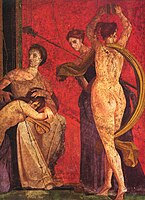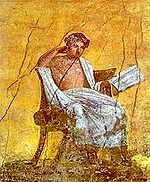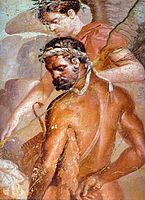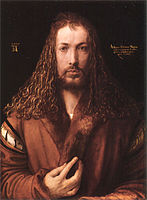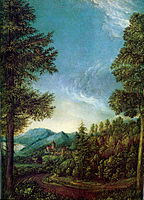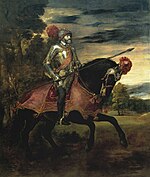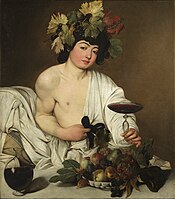painting
The painting is one addition to the architecture , the sculpture , the graphic and the drawing of the classic genres of the visual arts . While sculpture and architecture produce three-dimensional works, painting, graphics and drawing are usually two-dimensional works. Those who perform painting are referred to as painters or artists . In contrast to drawing, this is done by applying damp colors to a painting surface using a brush, spatula or other tools. These techniques are summarized under the term painting techniques . As a rule, printing techniques are not counted among the painting techniques , even if wet paint is used.
In addition to panel and wall painting, a distinction is also made between glass and book painting as well as painting on clay, ceramics (e.g. Greek vase painting ) or other surfaces (paper, plastic).
history
prehistory
The oldest evidence of painting are the cave paintings with depictions of animals from the last Ice Age and the Upper Palaeolithic . These paintings and drawings, as well as reliefs and sculptures , are known as artistic forms of expression from the time between 35,000 and 10,000 years ago. European cave paintings were mainly discovered in Spain and France , such as the murals in the Lascaux cave in southern France in 1940, which mostly show animal motifs. Cattle , deer and horses were depicted in an impressive way and thus belong to the oldest known pictorial motifs of mankind.
Early rock and cave paintings are also known from Africa , Asia and Australia . In the Middle East there is numerous evidence of early paintings as early as the Neolithic . Above all, the emergence of painted ceramics and wall painting should be mentioned here. Numerous remains of prehistoric wall paintings were found in Çatalhöyük in Asia Minor and date to around 6000 BC. Chr.
antiquity
In the cultures of the Ancient Near East , painting, and probably wall painting in particular , was popular from 10,000 BC. Widespread, but relatively little has survived. Some examples come from the palace of Mari , while only fragments exist from the palaces of the Hittites , but these hardly allow a picture of the painting that once existed. Finally, other examples are known from the Assyrians , especially of wall paintings. The wall paintings of ancient Egypt (from 3000 BC) and the Minoan frescoes in Crete (from 2000 BC ) are of a later date . The painting of the ancient Egyptians is mainly known from wall paintings from burial chapels, from coffins and from the painting of books of the dead .
In the third century AD, the Greek writer Philostratos described painting as an invention of the gods ( Eikones 1 ). This and other statements by ancient authors testify that painting was particularly highly regarded, even higher than sculpture . In ancient Greece, wood was the main image carrier , as well as stone, clay and stucco. The use of ivory, glass and canvas hardly occurs, but only a few remains of ancient Greek painting have survived. After the fall of the Minoan - Mycenaean culture with its high quality fresco painting (for example in Knossos ), Greek wall painting did not resume until the eighth century BC. A.
The number and type of archaeological evidence of Roman painting differ significantly from that of Greek painting. Numerous evidence of Roman wall painting have been preserved , although it is obviously a Roman phenomenon and not just a coincidence of the traditional situation. In his Naturalis Historia (35, 118), Pliny complains about the extensive change from panel to wall painting. Many of these frescoes come from the cities of Pompeii and Herculaneum, which were buried in AD 79 .
- Wall painting of Roman antiquity
Fresco from the Villa dei Misteri , Pompeii
Menandros , fresco from the House of Menander , Pompeii
Fresco from the Temple of Isis , Pompeii
Punishment of Ixion , Casa dei Vettii , Pompeii
Fresco from Herculaneum
Hercules , fresco from Herculaneum
Mummy portrait from Al-Fayyūm
middle Ages
The painting of the ancient world survived mainly in the wall paintings of the churches and vignettes of books. In the Middle Ages , illumination was therefore of paramount importance. The panel painting as a painting on an independent surface to be painted - in other words on the wooden plate, then on canvas - evolved only gradually new.
Until the modern era, European painting was almost exclusively religiously shaped by the church clients. Churches and monasteries were painted and church choirs and devotional chapels were decorated with altarpieces. Other subjects such as portrait painting , genre painting , landscape painting or still life did not appear until the late Middle Ages and in Renaissance painting .
- Wall paintings and book paintings from the Middle Ages
Fresco from a cycle of St. Francis by Giotto di Bondone , late 13th century
Illumination for the month of “August” from the Très Riches Heures des Duc de Berry, 1412–1416
Illumination from the Ingeborg Psalter , France, around 1200
Illumination , France, 1371–1372
Modern times
Renaissance and Baroque
Painting took a significant development in the Renaissance with the sustained further development of the techniques of oil painting , the central perspective , the depiction of allegorical motifs of antiquity and the emphasis on individual characters in the representation of people with the aid of knowledge of anatomy .
Jan van Eyck (around 1390–1441) created independent images and portraits for the first time ; Albrecht Dürer (1471–1528) painted the first known autonomous self-portrait in Europe in 1493 ; Albrecht Altdorfer (around 1480–1538) was the first painter to make the landscape the main theme.
Above all, the Italian painting of the High Renaissance in the cities of Florence , Venice and Rome produced important works by the painters Leonardo da Vinci (1452–1519), Michelangelo (1475–1564), Raphael (1483–1520) and Titian (1477–1576) that are exemplary in perspective, shape, color, expressiveness and painterly brilliance and have had a lasting influence on the visual arts of Europe to this day.
- Painting from the Renaissance period
Albrecht Dürer , self-portrait, 1500
Raffael , Sistine Madonna , 1513–1514
Albrecht Altdorfer , Danube Landscape with Wörth Castle, around 1522
In the 17th century, the beginning of the Baroque era , numerous Dutch painters painted still lifes . Jan Vermeer (1632–1675) was at the same time a master of vedute painting and genre painting . Other important painters in Italy Michelangelo da Caravaggio , in Spain Diego Velázquez and Bartolomé Esteban Murillo , France Nicolas Poussin and Claude Lorrain , and the Netherlands, Peter Paul Rubens and Rembrandt , who as a master of chiaroscuro ( light and shade applies).
- Painting from the Baroque period
Michelangelo da Caravaggio , Bacchus , around 1596
Peter Paul Rubens , Boreas kidnaps Oreithya , around 1620
Pieter Claesz , Still Life with Musical Instruments, 1623
Rembrandt , Danae , 1636-1643
Jan Vermeer van Delft , View of Delft , 1660–1661
Modern

With the advent of photography , painting had to face new challenges and tasks that had an impact on its development in the 19th century . Up until the middle of the 19th century, the pictures were mostly created in artist studios. The Braith-Mali-Museum in Biberach an der Riss houses such original studios.
Open-air painting begins with the French impressionist painters . Camille Pissarro (1830–1903), Édouard Manet (1832–1883), Edgar Degas (1834–1917), Paul Cézanne (1839–1906), Alfred Sisley (1839–1899), Claude Monet (1840–1926 ) belong to this direction ), Berthe Morisot (1841–1895) and Pierre-Auguste Renoir (1841–1919). Paul Cézanne, like Vincent van Gogh , Paul Gauguin and Edvard Munch to a certain extent , can be described as a pioneer of modernity. Cézanne's works in particular mark the transition, as he is increasingly detaching himself from the reproduction of reality and turns to the means of painting, to pure form and color.
Important modern trends in the first half of the 20th century are Fauvism , Cubism , Dadaism , Surrealism and the Russian avant-garde . National peculiarities are Expressionism and New Objectivity (Germany), Futurism (Italy), Cubo-Futurism , Constructivism and Suprematism (Russia) and Vorticism (England). Another development of modern art is abstract painting , which in turn takes the form of different styles. Other important styles of the 20th century are tachism and largely after 1950 the Informel . Legendary painters such as Piet Mondrian (1872–1944), Kasimir Malewitsch (1879–1935) and Pablo Picasso (1881–1973) had a decisive artistic influence on painting in the 20th century .
Painting from the second half of the 20th century until today
In the bipolar world of the Cold War , art, and with it painting, took two paths. In the Soviet sphere of influence she was primarily obliged to carry out state propaganda (including socialist realism ). Well-known painters in socialism were Willi Sitte , Bernhard Heisig , Werner Tübke . The western world, on the other hand, continued to play the ideas of modernity into the eighties. There was a constant expansion of the concept of art ( conceptual art , Fluxus , happening ). The classic categories of painting, sculpture and graphics lost more and more weight.
The fifties were largely characterized by abstract expressive or constructive tendencies, which can be summarized under the terms Informel , Tachism , American " abstract expressionism " and concrete art , in which painting still plays an essential role. With the economic consolidation of the western hemisphere and its cultural center New York, the art world split from the sixties into a formalistic branch, minimal art and ultimately conceptual art on the one hand, and pop art on the other. The latter refers to the colorful advertising and media language and thus also builds on the painted and representative image. (including Andy Warhol , Robert Rauschenberg , Roy Lichtenstein , in Germany as “ capitalist realism ” with Gerhard Richter , Sigmar Polke ).
Parallel to this development, the interface between painting and photography, which were largely separate at that time, was closed in the early 1970s with the work of the photo artists Pierre Cordier ( chimigrams ) and Josef H. Neumann ( chemograms ). In 1974, Josef H. Neumann's chemograms closed the separation of the painterly ground and the photographic layer, in that, in a symbiosis that had never existed up to that point in time, they were unmistakably unique in a simultaneous painterly and real photographic perspective within a photographic layer in colors and Forms united.
- Chemograms and chimigrams
Josef H. Neumann : Chemogram, Gustav I (1976)
Paolo Monti : Chimigramm, fotografica series, 1970
The rapid change of different styles ( action painting , op art , photo-realism , hard edge etc .; see also styles in painting ) came to an end in the eighties with the arrival of postmodernism , at the same time the " new wild ones " (including Jörg Immendorff , Walter Dahn , Kurt Schulzke , Albert Oehlen , Markus Oehlen , Salomé ; Georg Baselitz , AR Penck and Markus Lüpertz come from an older generation, but gained in importance at that time) and the " Transavantgarde " (including Sandro Chia , Enzo Cucchi , Francesco Clemente ) for a renaissance of the expressive painted image.
The confrontation with the new digital media shaped the tendencies of the nineties, while the fall of the Berlin Wall in 1989 also prepared the ground internationally for young painters who had received their training at universities in Leipzig, Berlin and Dresden and later on at the turn of the millennium were partly summarized under the term “ New Leipzig School ” (especially Neo Rauch ). The first decade of the 21st century was primarily concerned with a partly mythologizing reappraisal of the past century (e.g. Jonathan Meese or Andy Hope 1930 ). The painted picture became more and more a stylistic device among many to convey the artist's message. Discussion no longer counted here, be it figurative, expressive, or constructive . Other important painters after 1945 were Frank Stella , Barnett Newman , Jasper Johns , Asger Jorn , Martin Kippenberger , Jackson Pollock , Günther Förg , Wolf Vostell , Imi Knoebel and Anselm Kiefer .
From a sociological point of view , the broad mass of painters particularly often belong to the working poor , that is to say to those people who live in poverty despite work.
Basic elements
The basic elements of paintings are the intensity, the color and the hue and the rhythm. In the case of paintings of contemporary art, non-traditional basic elements are also described. The intensity of a painting is defined by shading, contrasting and the use of neighboring elements with different color intensities. The juxtaposition of picture elements with the same color intensity can only produce symbolic differentiation. The perception of color and hue is subjective, but can produce culturally different psychological effects. The color black is more likely to be associated with mourning in the west, while the color of mourning in the east is white. There are numerous theories of color theory by well-known artists, scientists and authors such as Goethe , Kandinsky and Newton . The rhythm is abstractly defined in the picture as a pause within a sequence and describes the distribution of shapes, colors and shades. The non-traditional basic elements were introduced by modern artists and include techniques that are not covered by the traditional basic elements. These are e.g. B. collages or the use of materials such as sand, straw or wood to give textures.
Painting techniques
- Ancient painting techniques
The preferred painting techniques in ancient times were encaustic and tempera painting . It was painted on wood, clay ( vase painting ), stone or on the fresh plaster (see fresco painting ). Due to the small amount of archaeological evidence, the color spectrum of antiquity can only be reconstructed very inadequately. However, it has been observed that the colors red and blue have retained the best.
Patron saint
The evangelist Luke is the patron saint of painters.
See also
literature
- General
- Wendy Beckett : The History of Painting. 8 centuries in 455 masterpieces . Verlag K. Müller, Cologne 2004, ISBN 3-89893-387-3 .
- Ernst Gombrich : The History of Art. Phaidon, Berlin, ISBN 978-0-7148-9137-8 .
- Egon von Vietinghoff : Handbook for the technique of painting . DuMont, Cologne 1983, ISBN 3-7701-1519-8 .
- History of painting: eras, styles, artists, masterpieces , Dorling Kindersley, 2015, ISBN 978-3831028252
- antiquity
- Hugo Blümner : Technology and terminology of trade and arts among Greeks and Romans . Olms, Hildesheim 1995, ISBN 3-487-02384-9 (4 vols., Repr. D. Ed. Leipzig 1884), see vol. 3, pp. 159-187.
- Vinzenz Brinkmann (ed.): Colorful gods. The colors of ancient sculpture . Staatliche Antikensammlungen und Glyptothek, Munich 2003, ISBN 3-933200-08-3 . (Exhibition catalog)
- Vinzenz Brinkmann: The polychromy of archaic and early classical sculpture . Biering & Brinkmann, Munich 2003, ISBN 3-930609-19-3 .
- Valentina Manzelli : La policromia nella statuaria greca arcaica . L'Erma, Rome 1994, ISBN 88-7062-854-X .
- Harald Mielsch : Roman wall painting . Theiss, Stuttgart 2001, ISBN 3-8062-1632-0 .
- Ingeborg Scheibler : Greek painting of antiquity . Beck, Munich 1994, ISBN 3-406-38492-7 .
- Monika Trümper : Greek painting . In: Tonio Hölscher : Classical Archeology. Basic knowledge . Theiss, Stuttgart 2002, ISBN 3-8062-1653-3 , pp. 277-292.
- Annegret Laabs , Uwe Gellner , (Ed.): Today: Painting. JOVIS Verlag, Berlin 2012, ISBN 978-3-86859-247-4 .
- Werner Hirschfeld : The history of Roman facade painting in the 16th and 17th centuries. Europäische Hochschulverlag, Bremen 2011, ISBN 978-3-86741-642-9 .
Web links
Individual evidence
- ↑ Hannes Schmidt: Comments on the chemograms by Josef Neumann. Exhibition in the photography studio gallery of Prof. Pan Walther. in: Photo press. Issue 22, 1976, p. 6.
- ↑ According to the Microcensus: Poverty Despite Employment ( Memento from June 10, 2007 in the Internet Archive ) (PDF file; 413 kB), download on September 25, 2012.
- ^ Oxford Dictionary of Modern and Contemporary Art
- ↑ Intensity ( Memento of the original from January 29, 2016 in the Internet Archive ) Info: The archive link was inserted automatically and has not yet been checked. Please check the original and archive link according to the instructions and then remove this notice.
- ^ Specialized vocabulary art



